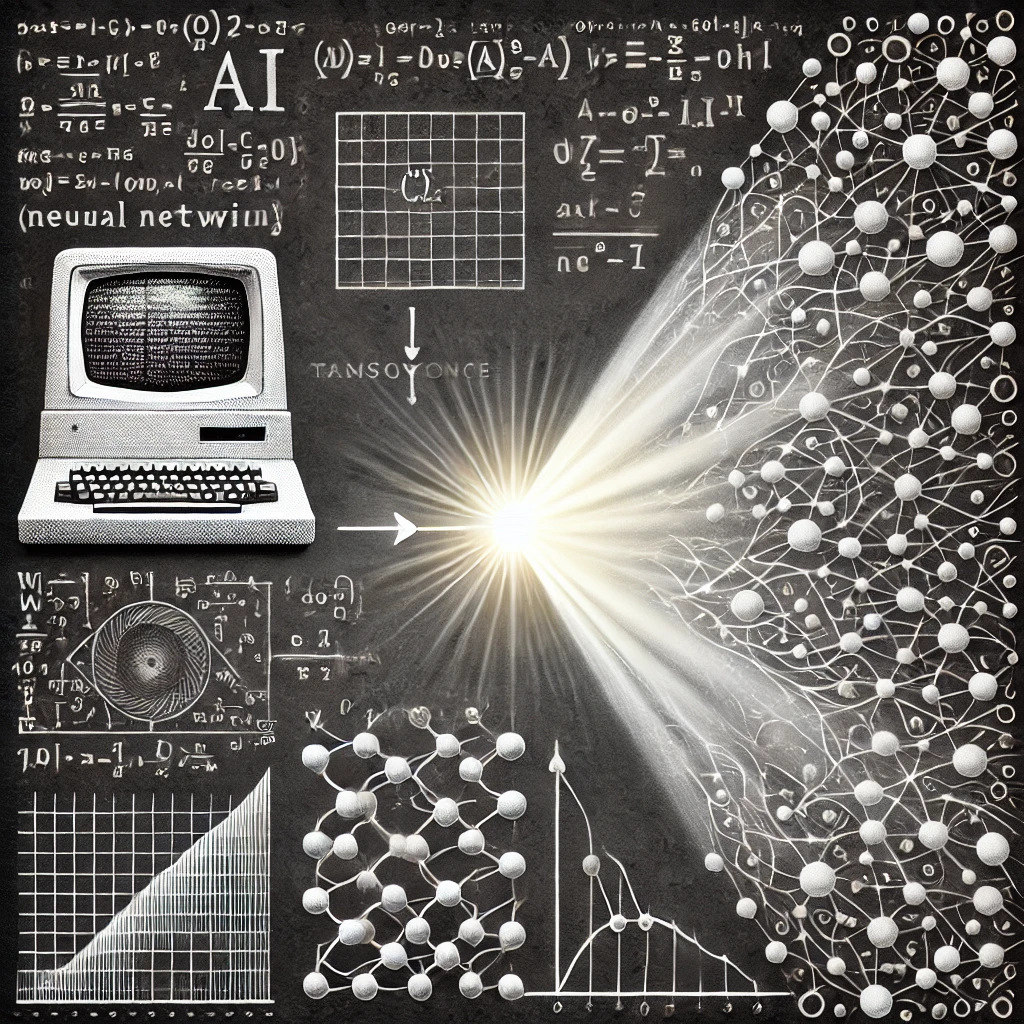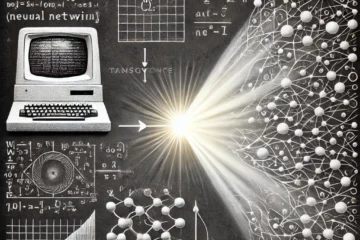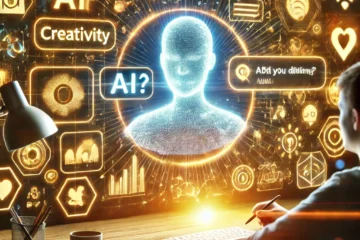
An image symbolizing the early days of AI and machine learning.
Machine Learning: Expanding the Horizons
Machine learning (ML) is a field of artificial intelligence (AI) that allows computers to learn from data, identify patterns, and make decisions without explicit programming. Rather than relying on hard-coded rules, machine learning algorithms use data and statistical methods to improve their performance over time.
In this section, we’ll explore the foundational principles of machine learning, key techniques, and a wide array of related concepts that have emerged in the field.
Key Terms and Concepts in Machine Learning
- Supervised Learning
Supervised learning is a machine learning technique where the algorithm learns from labelled training data to make predictions or classifications. The algorithm is trained with input-output pairs, and its goal is to map the input to the correct output. Key algorithms in supervised learning include:- Linear Regression
- Logistic Regression
- Support Vector Machines (SVM)
- Decision Trees
- Unsupervised Learning
Unsupervised learning involves training an algorithm on data that has no labels. The algorithm tries to find hidden patterns or intrinsic structures in the data. Common unsupervised learning techniques include:- K-Means Clustering
- Principal Component Analysis (PCA)
- Hierarchical Clustering
- Reinforcement Learning
In reinforcement learning, an agent learns to make decisions by performing actions in an environment and receiving feedback through rewards or penalties. This type of learning is inspired by behavioural psychology and is used in applications such as robotics and gaming. - Deep Learning
A subset of machine learning, deep learning involves the use of neural networks with many layers (hence “deep”). These networks are capable of learning complex representations of data and are often used in image and speech recognition, natural language processing, and more. - Neural Networks
Neural networks are computational models inspired by the human brain. They consist of interconnected nodes (neurons) that process data and pass information through layers. Neural networks are the foundation of many deep learning applications. - Feature Engineering
Feature engineering is the process of selecting and transforming raw data into meaningful input features for machine learning models. This step is crucial for improving the performance of machine learning algorithms. - Overfitting and Underfitting
These are common issues in machine learning. Overfitting occurs when a model learns the training data too well, capturing noise rather than general patterns. Underfitting happens when the model is too simple and fails to capture the underlying trends in the data. - Cross-Validation
Cross-validation is a technique used to assess the performance of machine learning models. It involves splitting the dataset into multiple subsets and training the model on different subsets while testing it on the remaining data. This helps ensure that the model generalizes well to new, unseen data. - Bias and Variance
These are two sources of errors in machine learning models. Bias refers to the error introduced by making assumptions about the model, while variance refers to the error introduced by the model’s sensitivity to small fluctuations in the training data. - Gradient Descent
Gradient descent is an optimization algorithm used to minimize the loss function in machine learning models. It iteratively adjusts the model parameters in the direction of the steepest descent to find the optimal values. - Natural Language Processing (NLP)
NLP is a field of machine learning focused on the interaction between computers and human language. Techniques like sentiment analysis, named entity recognition, and machine translation are all powered by NLP. - Transfer Learning
Transfer learning allows a machine learning model to be trained on one task and then fine-tuned for a different, but related, task. This is particularly useful in situations where limited data is available for the new task. - Ensemble Methods
Ensemble methods combine multiple models to improve the overall performance. Techniques such as Bagging, Boosting, and Stacking leverage the strengths of individual models to create a stronger, more accurate model. - Model Evaluation Metrics
There are several ways to evaluate the performance of a machine learning model:- Accuracy
- Precision
- Recall
- F1 Score
- Confusion Matrix
- Area Under the ROC Curve (AUC-ROC)
- Data Augmentation
Data augmentation is a technique used to artificially expand the size of a dataset by applying transformations to the data, such as rotation, flipping, and scaling for images or synonym replacement for text. - Generative Models
These models aim to generate new data that resembles the training data. Generative Adversarial Networks (GANs) and Variational Autoencoders (VAEs) are examples of generative models used in AI and machine learning. - AI Ethics
As AI becomes increasingly pervasive, ethical concerns such as privacy, fairness, accountability, and transparency are gaining attention. Ensuring that AI models make decisions in ways that align with human values and societal norms is critical.
Applications of Machine Learning
Machine learning has a vast array of applications across different industries:
- Healthcare: Predicting patient outcomes, identifying diseases in medical imaging, and drug discovery.
- Finance: Fraud detection, algorithmic trading, and risk assessment.
- Retail: Personalized recommendations, demand forecasting, and inventory management.
- Autonomous Vehicles: Self-driving cars and real-time decision-making.
- Entertainment: Content recommendation systems, video game AI, and movie suggestions.
Challenges and Future of Machine Learning
Despite its tremendous potential, machine learning faces several challenges:
- Data Privacy: Handling sensitive information in a way that respects privacy is a growing concern.
- Bias in Algorithms: Ensuring fairness and eliminating biases in machine learning models is a crucial area of research.
- Explainability: Many machine learning models, especially deep learning networks, are often seen as “black boxes,” meaning their decision-making process is not easily interpretable. Increasing transparency and explainability is essential.
- Energy Consumption: Training complex models requires substantial computational resources and energy. Making models more efficient is a key focus area.
As machine learning continues to evolve, the integration of new techniques, such as federated learning and quantum machine learning, promises to push the boundaries even further.
Relevant Links:
- Google AI – Machine Learning
- Google’s dedicated AI education page, offering an introduction to machine learning, tutorials, and resources.
- Stanford University’s Machine Learning Course (CS229)
- A famous course offering a comprehensive introduction to machine learning, led by Andrew Ng.
- Fast.ai – Practical Deep Learning for Coders
- A free, hands-on deep learning course focusing on practical applications.
- Machine Learning Mastery
- A great resource for machine learning tutorials, guides, and books.
- MIT OpenCourseWare – Machine Learning
- An introductory course on machine learning with videos, notes, and assignments from MIT.
- Kaggle – Learn Machine Learning
- Kaggle’s own learning platform, offering free interactive courses in machine learning.
- The Elements of Statistical Learning (Book)
- A well-known textbook by Trevor Hastie, Robert Tibshirani, and Jerome Friedman, providing a solid theoretical foundation in machine learning.
Relevant Papers:
- “A Few Useful Things to Know About Machine Learning” by Pedro Domingos
- This paper discusses the basic principles of machine learning in a simple and accessible way. It helps build a mental model of how machine learning works.
- Link to Paper
- “Understanding Machine Learning: From Theory to Algorithms” by Shai Shalev-Shwartz and Shai Ben-David
- A comprehensive book that provides in-depth coverage of the theory behind machine learning algorithms, suited for those looking to dive deep into machine learning concepts.
- Link to Book
- “Deep Learning” by Ian Goodfellow, Yoshua Bengio, and Aaron Courville
- A book that explores deep learning techniques and the practical application of neural networks.
- Link to Book
- “ImageNet Classification with Deep Convolutional Neural Networks” by Alex Krizhevsky, Ilya Sutskever, Geoffrey Hinton
- This is the seminal paper that introduced the widely adopted deep convolutional neural network architecture used for image classification tasks.
- Link to Paper
- “Mastering Chess and Shogi by Self-Play with a General Reinforcement Learning Algorithm” by Silver, et al.
- This paper discusses AlphaZero, a deep reinforcement learning algorithm developed by DeepMind that mastered chess, shogi, and Go.
- Link to Paper
- “Sequence to Sequence Learning with Neural Networks” by Ilya Sutskever, Oriol Vinyals, Quoc V. Le
- This paper introduces sequence-to-sequence models, a crucial development in natural language processing.
- Link to Paper
-
“The Importance of Data in Machine Learning” by various authors
- A look at the critical role data plays in training machine learning algorithms, and the importance of clean, well-prepared data.
- Link to Paper





0 Comments